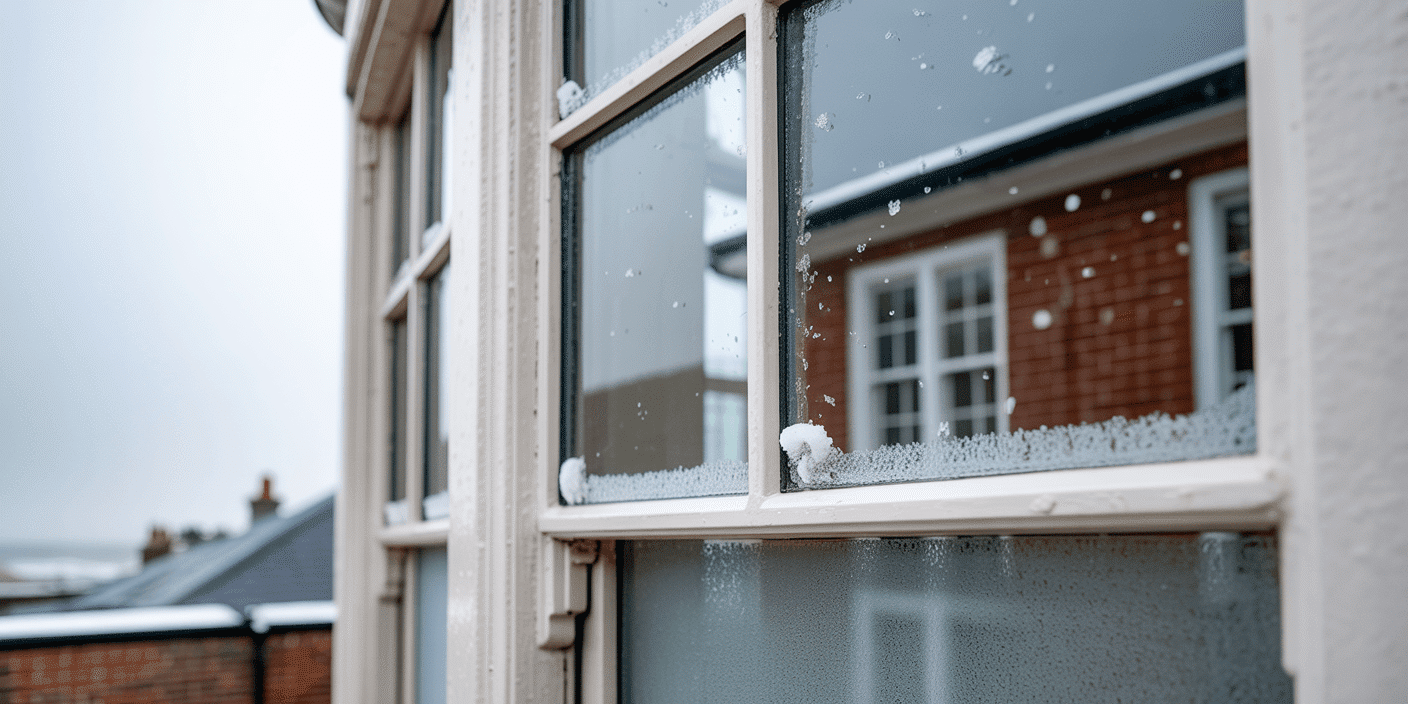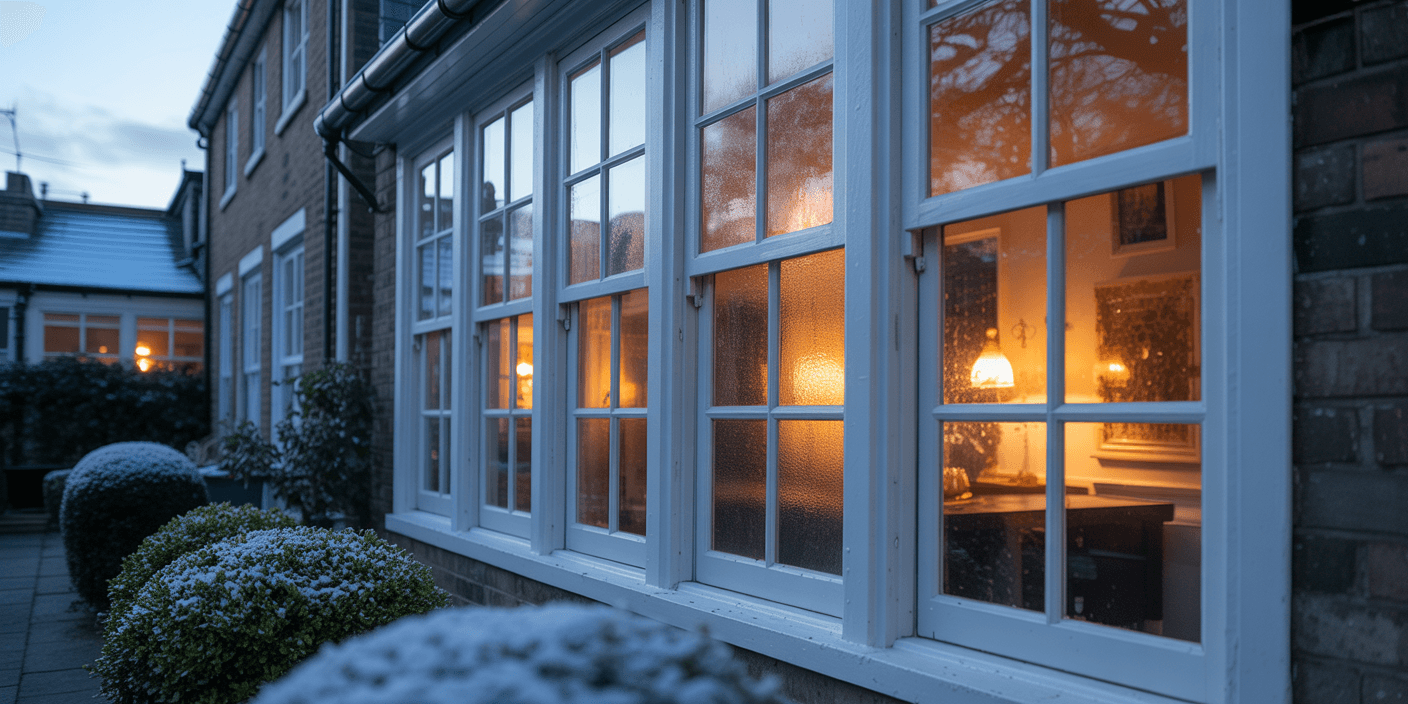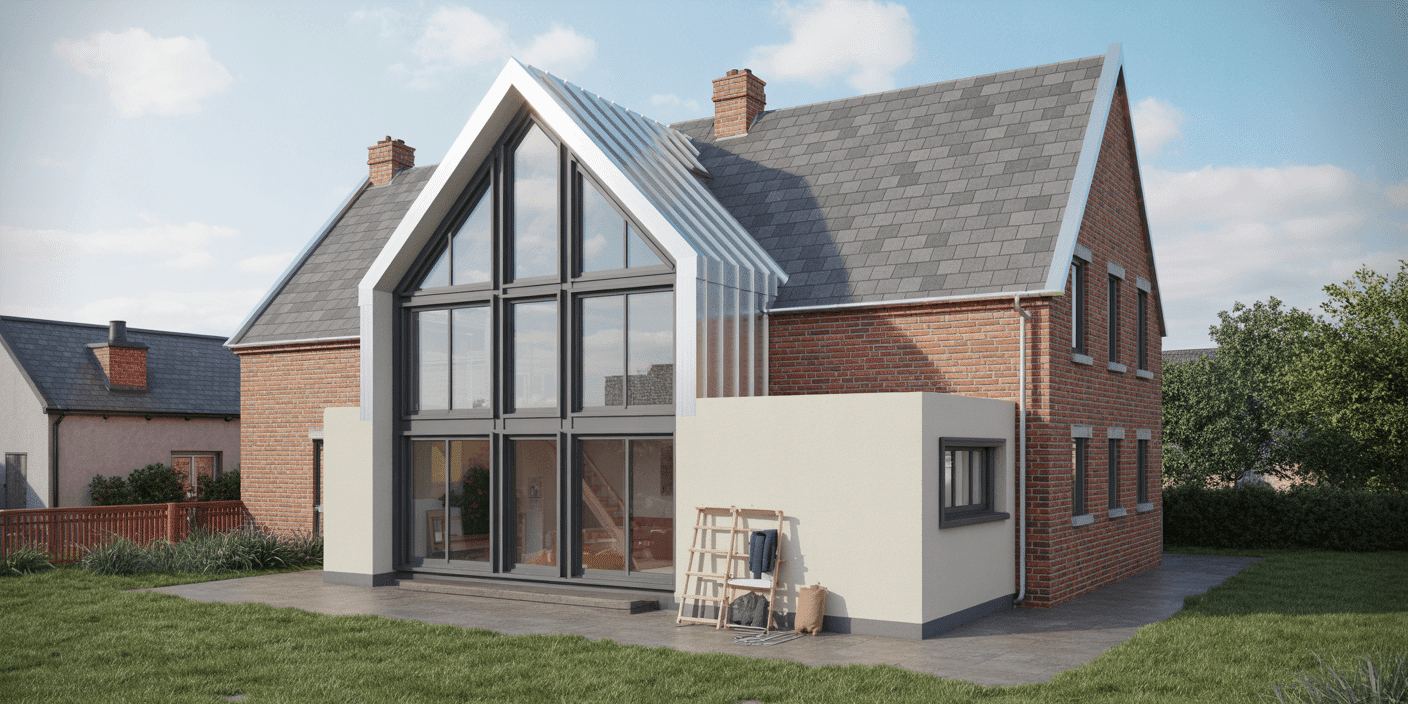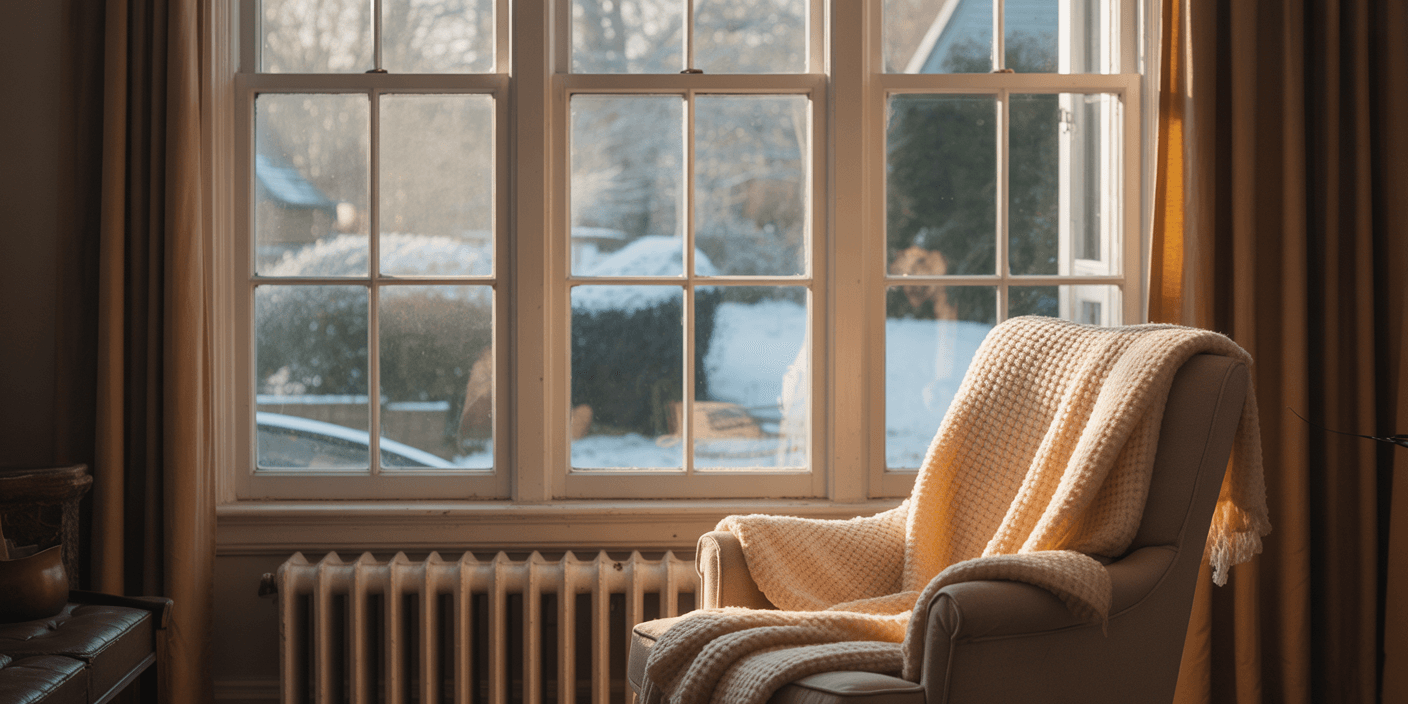The Unseen Cost of Underperforming Windows
Most homeowners regard their windows as little more than passive apertures — allowing in light, shielding against the elements. In truth, windows are critical components of a building’s thermal envelope, and when their performance is poor, the consequences are both silent and substantial.
Measured by U-value — the rate at which heat escapes — underperforming windows can be among the most significant sources of energy loss in a home. Often more detrimental than outdated boilers or roofing insulation, inefficient glazing and frames allow heat to dissipate invisibly, forcing systems to work harder while comfort steadily declines.
Crucially, poor thermal performance rarely announces itself. There is no obvious flaw. No dramatic draught. Yet behind the charm of a sash or casement frame, especially in heritage properties, lies the potential for sustained energy inefficiency — concealed behind layers of paint and tradition.
This is the architectural paradox: the enduring elegance of traditional joinery masking outdated performance. And it is a problem repeated in homes across the UK.
To address this, discerning property owners and conservation architects increasingly turn to specialists who unite craftsmanship with compliance — who can preserve the spirit of the window while restoring its purpose.
In the sections that follow, we examine how to identify when your windows are underperforming — and what corrective action may be required before comfort, cost-efficiency, and regulatory compliance are further compromised.
What Is a U‑Value, and Why Should You Care?
Every window in Britain has a number attached to it, even if you’ve never heard it spoken aloud. That number is its U‑value — and it quietly determines how warm, efficient and comfortable your home really is.
Put simply, a U‑value measures how much heat escapes through a material. The lower the number, the better the insulation. Single glazing often sits at a shocking 5.0 W/m²·K. Old double glazing may limp along at 2.8. Modern high‑performance windows — the kind you see in well‑designed, energy‑conscious homes — achieve 1.4 or even 1.2 W/m²·K. Triple glazing or Passivhaus‑grade systems can fall below 0.8.
This is not dry technical trivia. A poor U‑value is like leaving your window cracked open all winter. You pay to heat the outdoors, you live with cold spots and draughts, and you watch your energy bills creep up each quarter.
Under current Part L of the Building Regulations, replacement windows in existing homes must not exceed 1.6 W/m²·K. In reality, if your windows are older, you’re probably far above that. Worse, the problem hides behind pristine paintwork and attractive joinery — you can’t see a U‑value with your eyes.
This is why architects, conservation officers and discerning homeowners alike increasingly insist on heritage‑appropriate windows with proven low U‑values. When crafted correctly, they blend period authenticity with modern thermal performance. When installed by specialists who understand both, they don’t just meet regulations — they transform the way a home feels.
In the next section, we’ll walk through the tell‑tale signs your current windows are failing you, so you can recognise the problem before it costs you another winter of wasted energy.
Tell-Tale Signs Your U-Values Are Failing
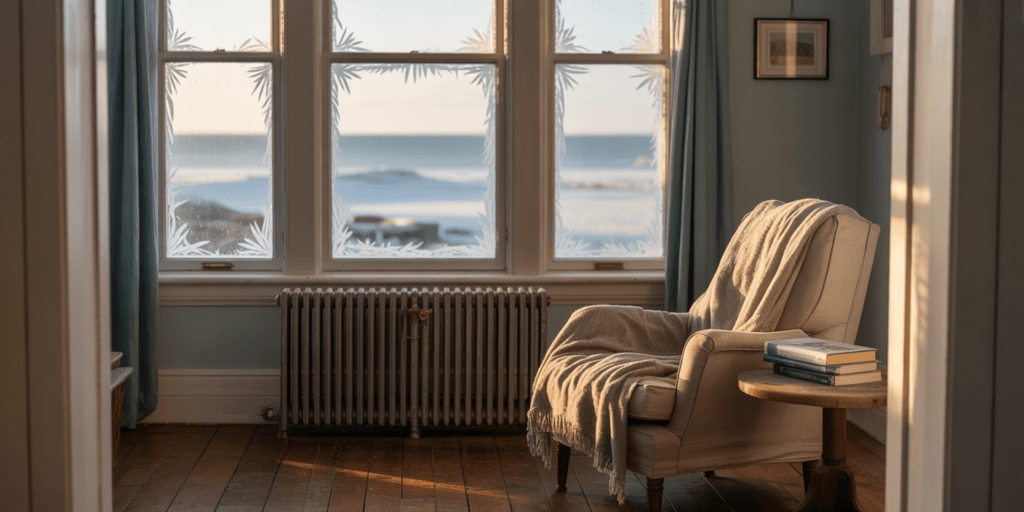
Not all discomfort is obvious. Many homeowners live with the symptoms of poor thermal performance for years, chalking it up to “just how old houses are.” But the reality is this: bad U-values have a way of making themselves felt, especially in the colder months — if you know where to look.
Here’s what to watch for:
Chilly rooms, even when the heating is on
If your central heating seems to work overtime just to maintain a livable temperature, your windows may be bleeding heat faster than your boiler can keep up. This is especially noticeable in the mornings or in rooms with large glazing areas.
Cold draughts and uneven temperatures
That creeping chill near the skirting board or under the sash? It’s not your imagination. Poor seals, single glazing, or outdated double glazing can allow cold air to penetrate – and warm air to escape – making rooms feel uneven and uncomfortable.
Condensation on the inside of windows
Waking up to droplets or streaks of moisture on your window panes is more than an inconvenience. It’s a sign that the inner surface of your glazing is too cold — a red flag for poor thermal performance. Left unresolved, condensation can lead to mould, timber decay, and respiratory issues.
Outside noise feels uncomfortably close
Thermal performance and acoustic insulation often go hand-in-hand. If you can hear passing traffic, barking dogs or noisy neighbours more than you’d like, chances are your U-values are letting you down too.
Mysteriously rising energy bills
You haven’t changed your habits, yet your gas or electricity bill is climbing. This is one of the clearest signs of a home that’s thermally inefficient. Old windows with high U-values demand more from your heating — and your wallet.
Many of these issues are subtle at first. But over time, they compound. What begins as mild discomfort becomes an expensive, energy-draining frustration. The good news? These signs aren’t random. They’re clues — and when interpreted correctly, they point directly to the root of the problem.
Sash Windows London has made it their mission to read these clues with surgical precision. They don’t just see windows — they see what they’re doing to your home, your bills, and your wellbeing.
The Hidden Costs of Doing Nothing
Most people underestimate how much their windows are costing them — not just in energy, but in comfort, health, and resale value. Doing nothing might feel like the easier path today, but the long-term toll of inaction adds up silently, month after month.
You’re burning cash every winter
Even with the heating cranked up, much of that warmth is lost through underperforming windows. You feel it as cold spots and rising bills. What you don’t see is the cumulative cost: hundreds, sometimes thousands of pounds per year wasted through inefficiency.
You’re inviting damp and decay into your home
Condensation on cold glass leads to mould, rot, and even damage to surrounding plasterwork and floors. Over time, this not only costs more to fix, but it also affects the very bones of your home. For listed and period properties, the consequences are even more critical.
You’re undermining your home’s value
A beautiful property with outdated windows is like a luxury car with worn tyres. Today’s buyers are energy-conscious. A poor EPC rating or visible signs of inefficient glazing can turn away serious offers — or become a negotiation weapon used against you.
You’re sacrificing year-round comfort
It’s not just about winter. In summer, poor U-value windows trap heat inside, creating unbearable indoor temperatures. Without effective insulation, you’re forced to rely on fans or makeshift cooling, which rarely work and only add to your bills.
You’re falling behind regulations
With tightening standards around Part L (conservation of fuel and power) and the rise of future-proofed retrofitting schemes, outdated glazing is fast becoming non-compliant. What’s tolerable today may soon be unacceptable tomorrow.
Neglect isn’t a neutral act. Every winter you delay replacing inefficient windows is another season spent overpaying for underperformance. For homeowners who value efficiency, wellbeing, and long-term investment, inaction is the most expensive choice of all.
Fortunately, there’s a smarter path — one that combines aesthetic integrity with cutting-edge thermal technology.
What Modern, High-Performance Windows Look Like
If your image of a “modern window” evokes clunky PVC frames or uninspiring plastic panes, it’s time to upgrade that mental picture. Today’s high-performance windows are a masterclass in craftsmanship and thermal engineering — combining cutting-edge efficiency with heritage charm.
Low U-Values, Built In — Not Bolted On
Modern windows aren’t retrofitted to be efficient. They are engineered that way from the core. High-performance glazing systems routinely achieve U-values as low as 1.2 W/m²·K — or better — dramatically reducing heat loss without compromising design.
Specialised glazing units use argon or krypton gas fills, warm-edge spacers, and low-emissivity (Low-E) coatings that reflect heat back into the room while still allowing sunlight to stream through.
Timber, Reimagined for Today’s Standards
Gone are the days when choosing timber meant sacrificing performance. Today’s timber sash and casement windows — especially those crafted by true specialists — use engineered hardwoods treated to resist warping and decay.
Combine this with thermally broken frames or aluminium-clad timber hybrids, and you have a window that looks authentic but performs like a modern passive system.
Seamless Airtightness & Draught-Proofing
Modern designs incorporate brush seals, compression gaskets, and multi-point locking systems, ensuring tight closure and eliminating draughts — a chronic weak point in old window setups.
The result? You keep the heat you’ve paid for. And the cold stays where it belongs — outside.
Glazing Options for Passive and Heritage Homes
Whether you’re restoring a Georgian townhouse or upgrading a contemporary home, high-performance windows come in a range of formats:
- Slimline double glazing for listed buildings
- Triple glazing for Passivhaus projects
- Alu-clad timber for exposed environments
- Composite frames for maximum durability
All of them with low U-values. All of them are designed to meet or exceed Part L of the Building Regulations.
This isn’t just progress for progress’ sake. These innovations are what today’s homes demand — especially when energy bills rise and thermal regulations tighten.
How Traditional Aesthetics and Modern Performance Can Coexist
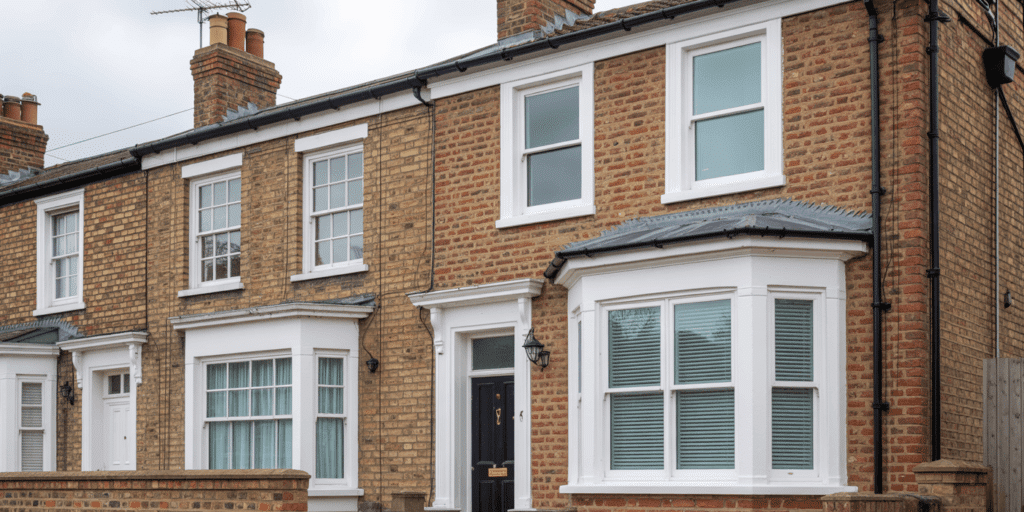
There’s a persistent myth in British homeownership: that if you want energy-efficient windows, you have to sacrifice character. That thermal performance and period beauty are somehow incompatible. To keep your home warm, you must give it a plastic facelift.
It’s simply not true.
Today’s finest windowmakers understand that true craftsmanship lies in harmonising performance with authenticity. And nowhere is that better exemplified than in the work of Sash Windows London.
Sash Windows – Reimagined, Not Replaced
Original sash windows are often beloved for their proportion, elegance and visual rhythm. But their thermal shortcomings are undeniable. Sash Windows London specialises in preserving this heritage charm while discreetly upgrading what lies beneath.
Using slim-profile double glazing, timber from sustainable sources, and precision draught-proofing systems, they deliver windows that are virtually indistinguishable from the originals — yet deliver U-values on par with modern builds.
Tailored for Conservation Areas and Listed Buildings
Navigating planning permissions can be complex. But Sash Windows London has years of experience working with conservation officers and heritage homeowners to deliver bespoke, regulation-compliant solutions. The result is windows that meet both Part L and heritage authenticity criteria.
They honour the spirit of the building while meeting the expectations of 21st-century living.
No Compromises – Just Intelligent Design
Whether you live in a Victorian terrace, an Edwardian villa, or a Georgian townhouse, the windows shouldn’t feel like an afterthought. They should be architecturally correct, visually seamless, and thermally sound.
This is the quiet genius behind Sash Windows London’s approach. They don’t ask you to choose between comfort and character. They deliver both.
Modern window systems are no longer at odds with traditional beauty. When executed correctly, they become invisible upgrades — silently saving you energy, reducing noise, and enhancing your home’s value, all while preserving its soul.
Understanding U-Values and Compliance: What the Law Now Demands
It’s no longer enough for windows to look the part. In the eyes of UK Building Regulations, they must also perform to standard — and increasingly, those standards are rising fast.
Whether you’re refurbishing a period property or upgrading a family home, understanding U-values and compliance is no longer optional — it’s essential. Not just for meeting legal requirements, but for future-proofing your investment.
What Is the Legal Threshold?
Under Approved Document Part L (Conservation of Fuel and Power), the minimum U-value requirement for replacement windows in existing dwellings is currently:
- 1.4 W/m²·K or lower for standard window installations.
This means any new or replacement window must retain heat at a much higher level than what older timber or even early double-glazing systems can manage.
New builds and extensions often have stricter requirements, and listed buildings may require negotiation — but the trajectory is clear: higher efficiency is becoming non-negotiable.
How Do You Achieve That in Real Homes?
Compliant U-values are not achieved by chance. It requires:
- Double or triple glazing with low-E coatings
- Warm edge spacers
- Inert gas fills (argon or krypton)
- Thermally broken or timber-clad frames
- Precision manufacturing tolerances for airtight seals
Sash Windows London understands the interplay of these components — not only to meet the legal benchmarks but to optimise performance across all seasons.
Navigating Conservation and Complexity
Listed properties and homes in conservation areas are often exempt from the full weight of Part L. But exemption doesn’t mean inaction. It means a smarter, more sensitive solution.
Sash Windows London works directly with conservation officers to ensure upgrades respect historical significance while still improving thermal efficiency, using slim-profile double glazing and handcrafted timber that passes aesthetic and performance tests alike.
Why This Matters
- Future-proofing: Energy standards are only tightening. Upgrading now avoids costly retrofits later.
- Resale Value: Energy ratings are increasingly scrutinised in property sales.
- Environmental Responsibility: Better U-values mean lower emissions and greater efficiency — every day.
In a regulatory landscape that’s evolving rapidly, having an expert by your side isn’t a luxury — it’s peace of mind.
Sash Windows London doesn’t just install windows. They deliver fully compliant systems that respect your property, your budget, and the law.
Now that you understand what’s at stake, it’s time to take action. In the final section, we’ll show you how to make the leap — without compromise.
Take Action Before Winter: A Window of Opportunity
There is a moment in every homeowner’s journey where charm alone no longer suffices. Where beauty must be matched by performance. Where comfort, cost, and conscience align — and the windows become more than a view: they become a shield.
That moment is now.
As winter nears, the vulnerabilities of poor U-value windows intensify. You’ll feel it in the draught that creeps along the skirting boards. In the boiler, working overtime to fight a silent thermal exodus. In the energy bills that rise like the frost on your panes.
This isn’t just inconvenient. It’s unsustainable — environmentally and financially.
Winter Waits for No One
By the time January winds howl through London’s terraces and villas, it’s already too late. That’s why autumn is not just a season — it’s your window of opportunity.
Lead times, manufacturing schedules, and installation slots are limited. And the best installers — like Sash Windows London — are in high demand among discerning homeowners who’ve done the math, felt the chill, and decided: enough.
Your Upgrade, Done Right
Choosing Sash Windows London means choosing a firm that respects your home’s heritage, understands the science beneath the frame, and delivers results that speak for themselves — not in loud advertising, but in quiet warmth, lower bills, and effortless elegance.
You won’t find pressure sales or one-size-fits-all frames. You’ll find bespoke, compliant, beautiful solutions — crafted with care and installed with precision.
Here’s What to Do Next
- Visit Sash Windows London to explore your upgrade options
- Book a free site survey with one of their trusted specialists
- Receive a no-pressure, tailored quote based on your needs and property type
- Start the journey to a warmer, quieter, and more efficient home — all without sacrificing the soul of your windows
Your windows should work for you — not against you. And the path to better begins with a single decision.
Don’t wait for the cold to remind you.
Act now. Secure your slot with Sash Windows London before winter closes in.
Because comfort isn’t seasonal. And neither is craftsmanship.
